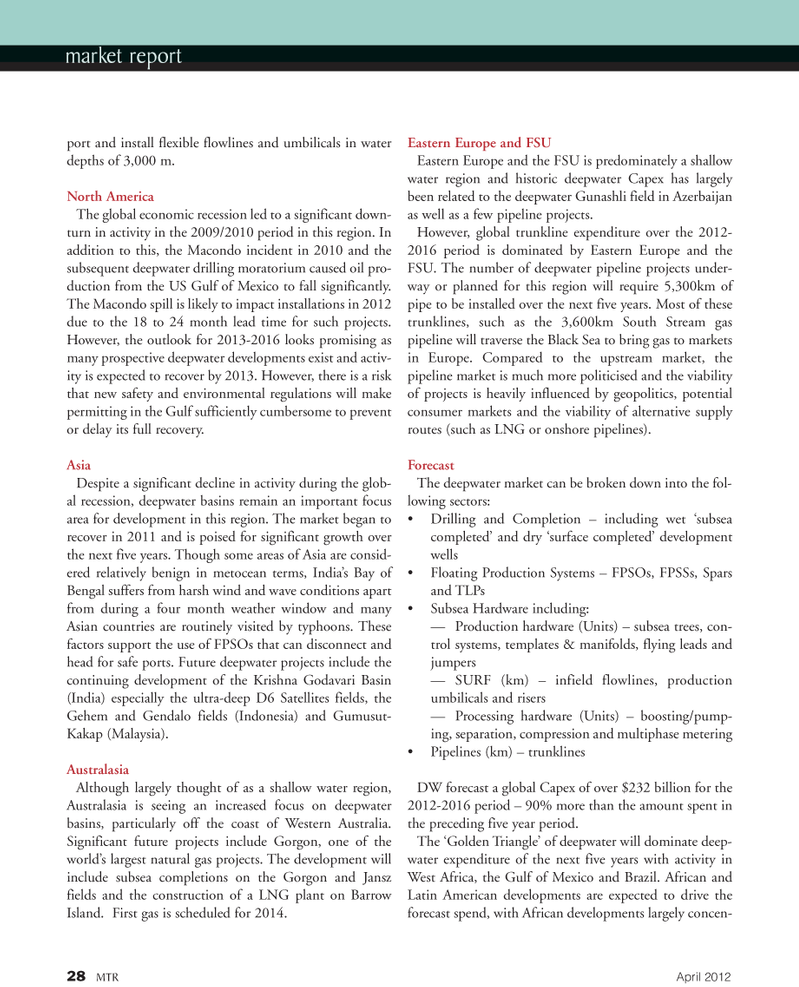
Page 28: of Marine Technology Magazine (April 2012)
Global Offshore Deepwater Report
Read this page in Pdf, Flash or Html5 edition of April 2012 Marine Technology Magazine
port and install flexible flowlines and umbilicals in water depths of 3,000 m. North America The global economic recession led to a significant down- turn in activity in the 2009/2010 period in this region. In addition to this, the Macondo incident in 2010 and the subsequent deepwater drilling moratorium caused oil pro- duction from the US Gulf of Mexico to fall significantly. The Macondo spill is likely to impact installations in 2012 due to the 18 to 24 month lead time for such projects. However, the outlook for 2013-2016 looks promising as many prospective deepwater developments exist and activ- ity is expected to recover by 2013. However, there is a risk that new safety and environmental regulations will make permitting in the Gulf sufficiently cumbersome to prevent or delay its full recovery. AsiaDespite a significant decline in activity during the glob- al recession, deepwater basins remain an important focus area for development in this region. The market began to recover in 2011 and is poised for significant growth over the next five years. Though some areas of Asia are consid- ered relatively benign in metocean terms, Indias Bay of Bengal suffers from harsh wind and wave conditions apart from during a four month weather window and many Asian countries are routinely visited by typhoons. These factors support the use of FPSOs that can disconnect and head for safe ports. Future deepwater projects include the continuing development of the Krishna Godavari Basin (India) especially the ultra-deep D6 Satellites fields, the Gehem and Gendalo fields (Indonesia) and Gumusut- Kakap (Malaysia). Australasia Although largely thought of as a shallow water region, Australasia is seeing an increased focus on deepwater basins, particularly off the coast of Western Australia. Significant future projects include Gorgon, one of the worlds largest natural gas projects. The development will include subsea completions on the Gorgon and Jansz fields and the construction of a LNG plant on Barrow Island. First gas is scheduled for 2014. Eastern Europe and FSU Eastern Europe and the FSU is predominately a shallow water region and historic deepwater Capex has largely been related to the deepwater Gunashli field in Azerbaijan as well as a few pipeline projects. However, global trunkline expenditure over the 2012- 2016 period is dominated by Eastern Europe and the FSU. The number of deepwater pipeline projects under- way or planned for this region will require 5,300km of pipe to be installed over the next five years. Most of these trunklines, such as the 3,600km South Stream gas pipeline will traverse the Black Sea to bring gas to markets in Europe. Compared to the upstream market, the pipeline market is much more politicised and the viability of projects is heavily influenced by geopolitics, potential consumer markets and the viability of alternative supply routes (such as LNG or onshore pipelines). Forecast The deepwater market can be broken down into the fol- lowing sectors: ?Drilling and Completion ? including wet subsea completed and dry surface completed development wells ?Floating Production Systems ? FPSOs, FPSSs, Spars and TLPs ?Subsea Hardware including: ?Production hardware (Units) ? subsea trees, con- trol systems, templates & manifolds, flying leads and jumpers?SURF (km) ? infield flowlines, production umbilicals and risers?Processing hardware (Units) ? boosting/pump- ing, separation, compression and multiphase metering ?Pipelines (km) ? trunklines DW forecast a global Capex of over $232 billion for the 2012-2016 period ? 90% more than the amount spent in the preceding five year period. The Golden Triangle of deepwater will dominate deep- water expenditure of the next five years with activity in West Africa, the Gulf of Mexico and Brazil. African and Latin American developments are expected to drive the forecast spend, with African developments largely concen- 28MTRApril 2012market report

 27
27

 29
29
